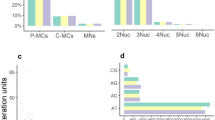Abstract
DNA from non-invasively collected samples may be used to identify individuals for monitoring birds. Here we describe 36 novel microsatellite loci from Bean Goose (Anser fabalis) identified using a next-generation sequencing approach. From 34 variable loci, we selected 12 tetranucleotide loci with short amplicon sizes, combined these into two multiplex PCR sets, and included a sex-typing marker. In 31 Bean Geese from a population in central Norway, we found 4–10 alleles per locus and observed heterozygosity ranging from 0.58 to 0.87. The combined probability of identity for the 12 loci was 6.5 × 10−13. These novel microsatellite loci and their multiplex PCR assays will be useful for genetic analyses of the Bean Goose, including typing of non-invasive samples such as molted feathers. Cross-species application of the two multiplex PCR assays revealed that all 12 loci amplified successfully in four other Anser species.
Zusammenfassung
Isolierung, Charakterisierung und Entwicklung einer Multiplex-PCR Methode für Mikrosatellitenloci von Saatgänsen ( Anser fabalis )
Für die Identifizierung von Individuen kann DNA aus nicht-invasiv gesammelten Proben zum Monitoring von Vögeln genutzt werden. In dieser Studie beschreiben wir 36 neue Mikrosatelliten-Genorte von Saatgänsen (Anser fabalis), die im Rahmen einer Next-Generation Sequenzierungsmethode identifiziert wurden. Aus 34 variablen Stellen selektierten wir 12 Tetranucleotidloci mit kurzen Amplikonlängen, kombinierten diese in zwei Multiplex-PCR Sets und fügten einen Geschlechtsbestimmungsmarker hinzu. Bei 31 Saatgänsen aus einer Population in Zentralnorwegen fanden wir 4–10 Allele pro Ort und stellten Heterozygositäten von 0.58–0.87 fest. Die kombinierte Wahrscheinlichkeit der Identität für die 12 Orte war 6.5 × 10−13. Diese neuen Mikrosatellitenorte und ihre Multiplex-PCR Methoden einschließlich der nicht-invasiven Probennahme wie beispielsweise Mauserfedern, können nützlich für genetische Analysen bei Saatgänsen sein. Die Anwendung der zwei Multiplex-PCR Methoden auf andere Arten zeigten, dass sich alle 12 Genorte erfolgreich bei vier anderen Anser-Arten amplifizierten.
Similar content being viewed by others
References
Broquet T, Ménard N, Petit E (2007) Noninvasive population genetics: a review of sample source, diet, fragment length and microsatellite motif effects on amplification success and genotyping error rates. Conserv Genet 8(1):249–260. doi:10.1007/s10592-006-9146-5
Dawson DA (2007) Genomic analysis of passerine birds using conserved microsatellite loci. University of Sheffield, UK
Excoffier L, Lischer HEL (2010) Arlequin suite ver 3.5: a new series of programs to perform population genetics analyses under Linux and Windows. Mol Ecol Res 10(3):564–567. doi:10.1111/j.1755-0998.2010.02847.x
Henriksen S, Hilmo O (eds) (2015) The 2015 Norwegian red list for species. Norwegian Biodiversity Information Centre, Norway
Horváth MB, Martínez-Cruz B, Negro JJ, Kalmár L, Godoy JA (2005) An overlooked DNA source for non-invasive genetic analysis in birds. J Avian Biol 36(1):84–88. doi:10.1111/j.0908-8857.2005.03370.x
Jacob G, Debrunner R, Gugerli F, Schmid B, Bollmann K (2010) Field surveys of Capercaillie (Tetrao urogallus) in the Swiss Alps underestimated local abundance of the species as revealed by genetic analyses of non-invasive samples. Conserv Genet 11(1):33–44. doi:10.1007/s10592-008-9794-8
Madsen J, Cracknell G, Fox AD (eds) (1999) Goose populations of the Western Palearctic. A review of status and distribution. Wetlands International Publication No. 48. Wetland International, Wageningen, The Netherlands, National Environmental Research Institute, Rönde, Denmark
Peakall R, Smouse PE (2012) GenAlEx 6.5: genetic analysis in Excel. Population genetic software for teaching and research—an update. Bioinformatics 28(19):2537–2539. doi:10.1093/bioinformatics/bts460
Primmer CR, Møller AP, Ellegren H (1996) A wide-range survey of cross-species microsatellite amplification in birds. Mol Ecol 5(3):365–378
Rice WR (1989) Analyzing tables of statistical tests. Evolution 43(1):223–225
Rudnick JA, Katzner TE, Bragin EA, Rhodes OE, Dewoody JA (2005) Using naturally shed feathers for individual identification, genetic parentage analyses, and population monitoring in an endangered Eastern Imperial Eagle (Aquila heliaca) population from Kazakhstan. Mol Ecol 14(10):2959–2967. doi:10.1111/j.1365-294X.2005.02641.x
Ruokonen M, Kvist L, Lumme J (2000) Close relatedness between mitochondrial DNA from seven Anser goose species. J Evol Biol 13(3):532–540. doi:10.1046/j.1420-9101.2000.00184.x
Schwartz MK, Luikart G, Waples RS (2007) Genetic monitoring as a promising tool for conservation and management. Trends Ecol Evol 22(1):25–33. doi:10.1016/j.tree.2006.08.009
Segelbacher G (2002) Noninvasive genetic analysis in birds: testing reliability of feather samples. Mol Ecol Notes 2(3):367–369. doi:10.1046/j.1471-8286.2002.00180.x
van Oosterhout C, Hutchinson WF, Wills DPM, Shipley P (2004) MICRO-CHECKER: software for identifying and correcting genotyping errors in microsatellite data. Mol Ecol Notes 4(3):535–538. doi:10.1111/j.1471-8286.2004.00684.x
Acknowledgments
We are grateful to Svein Karlsen and Øyvind Spjøtvoll for providing A. f. fabalis shed feathers, and the Natural History Museum in Oslo for providing samples from A. albifrons (NHMO-BI-26959/1-B and NHMO-BI-35338/1-B), A. erythropus (NHMO-BI-18687/1-B, NHMO-BI-18688/1-B and NHMO-BI-18689/1-B) and A. f. fabalis (NHMO-BI-26976/1-B and NHMO-BI-26977/1-B). We thank Deborah A. Dawson for kindly providing the sex-typing markers. Financial support was received from the County administration in Nord-Trøndelag and the Norwegian Environment Agency. Permissions for Bean Goose catching and tissue sampling were approved by the Norwegian Animal Research Authority (NARA, ID 1775 and ref. 2011/64833) and the Norwegian Environment Agency (ref. 2012/1756).
Author information
Authors and Affiliations
Corresponding author
Additional information
Communicated by M. Wink.
Rights and permissions
About this article
Cite this article
Kleven, O., Kroglund, R.T. & Østnes, J.E. Isolation, characterization and multiplex PCR development of Bean Goose (Anser fabalis) microsatellite loci. J Ornithol 157, 641–646 (2016). https://doi.org/10.1007/s10336-015-1309-z
Received:
Revised:
Accepted:
Published:
Issue Date:
DOI: https://doi.org/10.1007/s10336-015-1309-z



